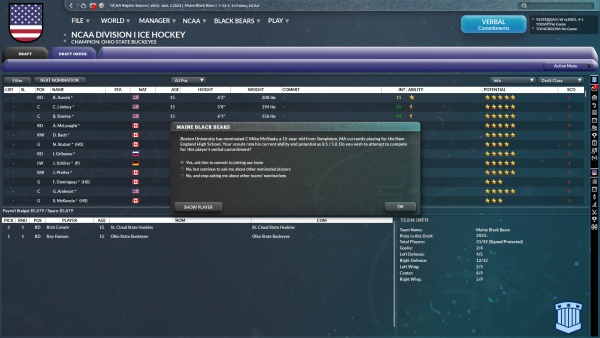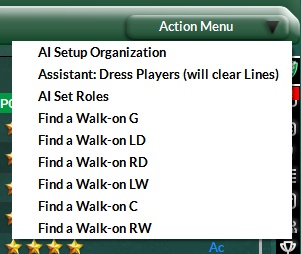| Find in this manual | ||
| Replace with | ||
College hockey has a number of features that are distinct from the professional leagues that form the large majority of FHM's playable leagues.

College Contracts and Scholarships
College "contracts" are quite different from those used in the rest of the game; the players aren't paid, but the contracts cannot be renewed, so the player is only bound to the team for four or five years at a maximum, after which their time in college hockey is over. The duration of the contract is handled via the "Academic Year" system; players begin in their Freshman season, followed by Sophomore, Junior, and Senior seasons; every year they progress to a new one, and then they're automatically released at the end of their senior season. Players will have their scholarship levels and academic years pre-assigned at the start of the game; you'll also begin with a few verbal commitments from players who've already committed to the school in real life. Top players can, and will, decide to leave early for professional contract offers (mainly from the NHL.)
Teams have a limited number of scholarships to offer players as incentives to join them. The number of scholarships available is team-specific, some teams have up to 18, others (notably the Ivy League teams) have none at all and must rely on their other strengths, be they academic standards or on-ice success, to attract players. Half-scholarships (counting as 0.5 scholarships against the limit) can also be offered but aren't as attractive to players.
Player Acquisition
Unlike other leagues, you can't sign or trade players. Player recruitment is handled via the Verbal Commitments (January 1) and National Signing Day (November 10) events, which operate in a manner similar to drafts in other leagues, with a major difference: rather than picking players directly, each team uses its turn to "nominate" a player, and then every other team gets a chance to compete for the player, including (on Signing Day) making a full or partial scholarship offer. Players will evaluate all their offers and choose a team based on various factors: presence of a scholarship, quality of the team, how close the team is to his hometown, academic quality of the school, the cost of attending the school without a scholarship, etc. Additionally, when trying to win over a player, teams will get a bonus derived from their Scouting Level in the region the player is playing in.
Players cannot choose to play both Canadian Major Junior hockey (the WHL, OHL, and QMJHL leagues) and US college hockey. You will only be able to recruit those that opt for the college route (a filter option is available to search for players who have that preference.) College teams recruit their players primarily from Junior A leagues in the US and Canada as well as high school teams. Recruiting tends to be somewhat regionally-based, although some teams will cast a much wider net. The very best American recruits tend to be part of the U.S. National Team Development Program (NTDP) teams.
Verbal Commitments

Verbal Commitments (January 1) are the first stage of the recruitment procedure; players as young as age 15 can be nominated but the commitment is non-binding (although it will remain in place until the player has to make a decision on National Signing Day.) Having a verbal commitment from a player gives a team a huge advantage in finalizing his acquisition on Singing Day. The team nominating a player receives a slight advantage when the player makes his decision.
Note that letting the AI complete the draft for you will take noticeably longer than a standard draft, as it needs to go through the competition process for every player.
National Signing Day

National Signing Day (November 10) decides which players will join which teams in the following season. Players must be at least 17 years old (as of the end of the current season) to sign; the nomination procedure is the same as for verbal commitments, but this time, the player is assigned a contract for the winning team. The contract will not begin until next July 1, so he won't be available immediately - he'll finish this season with his current team.
As with Verbal Commitments, letting the AI complete the draft for you will take noticeably longer than a standard draft, as it needs to go through the competition process for every player.
Walk-On Players

Aside from the recruitment system, if you need a player in an emergency (for example, if can't dress enough players for a game due to injuries), the "Find a Walk-on" options on the roster screen's Action Menu will find a player for you. They'll first attempt to assign a college-eligible free agent to you - this player is assumed to already be attending your college, and joins the team as a "walk-on" player with no scholarship. If no such player can be found, the game will generate a new one (of very poor quality) for you. Generally, the walk-ons will never be particularly good, so this isn't a viable option to build your team, just a way to fill spots when you have no other option.
Academic Eligibility and Redshirting
Since your players are student-athletes, they must maintain their grades in order to play. Players, particularly those with lower intelligence ratings, may lose their academic eligibility (or fail to get in the first place), which prevents them from playing. This is checked every year for every player, just before the preseason begins. If one of your players becomes academically ineligible, you'll be notified that he can't play this season; you have two options to respond with: release him from the team, opening a spot for another player, or "redshirting" him. Redshirting keeps him on the roster and prevents his academic year from progressing (so he'll spend five seasons with you instead of four, assuming he doesn't leave early.) He still can't play this year, and players can only redshirt one season, so an academic failure after having already redshirted a season is likely the end of thge player's college career. The redshirted player still has to go through the academic eligibility check again at the start of the next preseason, but there's less of a chance of failing this for players who've been around for more than a season. The players can, but usually won't, refuse the redshirt request; if that happens, they leave the team.
You can also redshirt players voluntarily (via right-click) so they can't play in the current season but won't advance their academic year at the start of the new season; this is primarily useful for keeping developing players when you've got a full roster of veteran players that will prevent them from getting playing time. It really isn't used that much in hockey (particularly when compared to other college sports like football), but there may be occasions when it makes sense to use this option.
Regular Season
Teams play varying numbers of games during the regular season, but typically a total in the thirties or forties. Games tend to be scheduled on weekends. A large percentage of these will be against teams in their cwn conference, but inter-conference play aslo occurs.
Polls
Once the season is underway, you will get a weekly news story showing the Top-20 rankings based on a survey of the league's coaches. Bear in mind that this is an informal poll and these rankings don't necessarily match the ones used to determine which teams make the playoffs.
Playoff System
The college playoffs begin with six conference tournaments, which are shown in the game as a pre-playoffs round on a tab labelled "CONF PO." Each conference has its own playoff format, with up to eight teams participating, based on regular-season standings. The winner of each of their tournaments advances to the next playoff round. Additionally, ten other teams (chosen by a complex ranking system) get selected for the next stage. The rankings messages you get during the season should give you a good idea as to which teams are in the playoff picture, but there will always be some uncertainty until the tournament participants are announced. Independent teams are not considered to be part of a conference, so they must attempt to win one of those ten ranked spots.
After the conference tournaments end, the first proper round of the playoffs is the four Regional tournaments, where four groups of four teams each play a two-round, single-game tournament that produces one winner. These four winners go on to the final stage: the Frozen Four tournament, which determines the overall champion via another two-round single-game tournament that ends in the National Championship game.